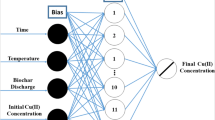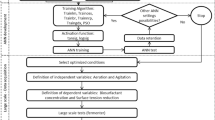Abstract
Optimization of environmental and medium parameters is an important step for bioprocess engineering. In the present study, the efficacies of Artificial Neural Networks (ANN) and Adaptive Neuro-Fuzzy Inference System (ANFIS) were compared for their utility in estimating biosurfactant production, surface tension reduction, and emulsification under different environmental and medium parameters. Biosurfactant was collected from the bacterial isolate FKOD36. In these models, temperature, pH, incubation period, carbon, nitrogen, and hydrocarbon sources were used as input variables, whereas surface tension reduction, emulsification index, and biosurfactant production were the dependent output variables. Models were trained for six inputs and three ANFIS sub-networks were developed for each output. Each of three ANFIS models was then used to predict one of the three outputs. The performance indices of both ANN and ANFIS illustrate that proposed ANFIS network produced better results with coefficient of determination (R2) values ranging from 0.96 to 0.99 for the training dataset and 0.90–0.99 for the validation dataset as compared to ANN which had R2 values of 0.95–0.99 for the training set and 0.89–0.98 testing set. Based on the results, the multilayer ANFIS model with its fuzzy application rules proved to give better prediction results than the ANN model.






Similar content being viewed by others
References
Ahmad Z, David C, Muhammad A, Muhammad I (2015) Biosurfactants and bioemulsifiers for treatment of industrial wastes. In: Chandra R (ed) Advances in biodegradation and bioremediation of industrial waste. CRC Press, Boca Raton, pp 122–152
Azadeh A, Saberi M, Anvari M, Azaron A, Mohammadi M (2011) An adaptive network based fuzzy inference system–genetic algorithm clustering ensemble algorithm for performance assessment and improvement of conventional power plants. Expert Syst Appl 38(3):2224–2234
Aziz K, Rahman A, Fang G, Shrestha S (2014) Application of artificial neural networks in regional flood frequency analysis: a case study for Australia. Stoch Environ Res Risk Assess 28(3):541–554
Banat IM, Makkar RS, Cameotra SS (2000) Potential commercial applications of microbial surfactants. Appl Microbiol Biotechnol 53:495–508
Bento FM, de Oliveira Camargo FA, Okeke BC, Frankenberger WT (2005) Diversity of biosurfactant producing microorganisms isolated from soils contaminated with diesel oil. Microbiol Res 160(3):249–255
Bilgehan M (2011) Comparison of ANFIS and NN models—With a study in critical buckling load estimation. Appl Soft Comput 11(4):3779–3791
Bosch MP, Robert M, Mercade M, Espuny M, Parra J, Guinea J (1988) Surface active compounds on microbial cultures: investigation and production of surface active compounds on microbial cultures. Tenside Deterg 25(4):208–211
Buragohain M, Mahanta C (2008) A novel approach for ANFIS modelling based on full factorial design. Appl Soft Comput 8(1):609–625
Chen L, Singh V, Guo S, Zhou J, Ye L (2014) Copula entropy coupled with artificial neural network for rainfall–runoff simulation. Stoch Environ Res Risk Assess 28(7):1755–1767
Das M, Das S, Mukherjee R (1998) Surface active properties of the culture filtrates of a Micrococcus species grown on n-alkanes and sugars. Bioresour Technol 63(3):231–235
Di Massimo C, Montague GA, Willis MJ, Tham MT, Morris AJ (1992) Towards improved penicillin fermentation via artificial neural networks. Comput Chem Eng 16(4):283–291
Ertunc HM, Hosoz M (2008) Comparative analysis of an evaporative condenser using artificial neural network and adaptive neuro-fuzzy inference system. Int J Refrig 31(8):1426–1436
Firat M, Güngör M (2010) Monthly total sediment forecasting using adaptive neuro fuzzy inference system. Stoch Environ Res Risk Assess 24(2):259–270
Gao C, Gemmer M, Zeng X, Liu B, Su B, Wen Y (2010) Projected streamflow in the Huaihe River Basin (2010–2100) using artificial neural network. Stoch Environ Res Risk Assess 24(5):685–697
Hodge J (1962) Determination of reducing sugars and carbohydrates. Methods carbohydr chem 1:380–394
Karim MN, Rivera SL (1992) Artificial neural networks in bioprocess state estimation. Modern biochemical engineering, vol 46. Springer, Berlin, pp 1–33
Khoshnevisan B, Rafiee S, Mousazadeh H (2014a) Application of multi-layer adaptive neuro-fuzzy inference system for estimation of greenhouse strawberry yield. Measurement 47:903–910
Khoshnevisan B, Rafiee S, Omid M, Mousazadeh H (2014b) Prediction of potato yield based on energy inputs using multi-layer adaptive neuro-fuzzy inference system. Measurement 47:521–530
Khoshnevisan B, Rafiee S, Iqbald J, Shamshirbande S, Omid M, Anuarf N, Abdul Wahabg A (2015) A comparative study between artificial neural networks and adaptive neuro-fuzzy inference systems for modeling energy consumption in greenhouse tomato production—A Case Study in Isfahan Province. J Agric Sci Technol 17(1):49–62
Kiviharju K, Salonen K, Moilanen U, Meskanen E, Leisola M, Eerikäinen T (2007) On-line biomass measurements in bioreactor cultivations: comparison study of two on-line probes. J Ind Microbiol Biotechnol 34(8):561–566
Kumar P, Kumar D, Jaipaul A (2012) Evaporation estimation using artificial neural networks and adaptive Neuro-Fuzzy inference system techniques. Pak J Meteorol 8(16):81–88
Linko S, Luopa J, Zhu YH (1997) Neural network as ‘softsensor’ in enzyme production. J Biotechnol 52:257–266
Mnif I, Sahnoun R, Ellouze-Chaabouni S, Ghribi D (2014) Evaluation of B. subtilis SPB1 biosurfactants’ potency for diesel-contaminated soil washing: optimization of oil desorption using Taguchi design. Environ Sci Pollut Res 21(2):851–861
Moghaddamnia A, Gousheh MG, Piri J, Amin S, Han D (2009a) Evaporation estimation using artificial neural networks and adaptive neuro-fuzzy inference system techniques. Adv Water Resour 32(1):88–97
Moghaddamnia A, Remesan R, Kashani MH, Mohammadi M, Han D, Piri J (2009b) Comparison of LLR, MLP, Elman, NNARX and ANFIS Models—with a case study in solar radiation estimation. J Atmos Solar Terr Phys 71(8–9):975–982
Mukherjee S, Das P, Sen R (2006) Towards commercial production of microbial surfactants. Trends Biotechnol 24(11):509–515
Mukherjee S, Das P, Sivapathasekaran C, Sen R (2008) Enhanced production of biosurfactant by a marine bacterium on statistical screening of nutritional parameters. Biochem Eng J 42(3):254–260
Mutalik SR, Vaidya BK, Joshi RM, Desai KM, Nene SN (2008) Use of response surface optimization for the production of biosurfactant from Rhodococcus spp. MTCC 2574. Bioresour Technol 99(16):7875–7880
Omrani E, Khoshnevisan B, Shamshirband S, Saboohi H, Anuar NB, Nasir MHNM (2014) Potential of radial basis function-based support vector regression for apple disease detection. Measurement 55:512–519
Pai T, Wan T, Hsu S, Chang T, Tsai Y, Lin C, Su H, Yu L (2009) Using fuzzy inference system to improve neural network for predicting hospital wastewater treatment plant effluent. Comput Chem Eng 33(7):1272–1278
Petković D, Shamshirband S, Anuar N, Naji S, Mat Kiah M, Gani A (2015) Adaptive neuro-fuzzy evaluation of wind farm power production as function of wind speed and direction. Stoch Environ Res Risk Assess 29(3):793–802
Ramedani Z, Omid M, Keyhani A, Shamshirband S, Khoshnevisan B (2014) Potential of radial basis function based support vector regression for global solar radiation prediction. Renew Sustain Energy Rev 39:1005–1011
Sen R (1997) Response surface optimization of the critical media components for the production of surfactin. J Chem Technol Biotechnol 68(3):263–270
Singh R, Kainthola A, Singh TN (2012) Estimation of elastic constant of rocks using an ANFIS approach. Appl Soft Comput 12(1):40–45
Sivapathasekaran C, Mukherjee S, Sen R (2010) Optimization of a marine medium for augmented biosurfactant production. Int J Chem React Eng 8:1–10
Taghadomi-Saberi S, Omid M, Emam-Djomeh Z, Ahmadi H (2014) Evaluating the potential of artificial neural network and neuro-fuzzy techniques for estimating antioxidant activity and anthocyanin content of sweet cherry during ripening by using image processing. J Sci Food Agric 94(1):95–101
Yilmaz I, Kaynar O (2011) Multiple regression, ANN (RBF, MLP) and ANFIS models for prediction of swell potential of clayey soils. Expert Syst Appl 38(5):5958–5966
Zhu YH, Rajalahti T, Linko S (1996) Application of neural networks to lysine production. Chem Eng J Biochem Eng J 62(3):207–214
Acknowledgments
The authors gratefully acknowledge support from the Higher Education Commission of Pakistan for providing an IRSIP Fellowship for the lead author and financial support for the project. The authors also thank Tehran University for its support of this project.
Author information
Authors and Affiliations
Corresponding authors
Rights and permissions
About this article
Cite this article
Ahmad, Z., Arshad, M., Crowley, D. et al. Comparative efficacy of ANN and ANFIS models in estimating biosurfactant production produced by Klebseilla sp. FKOD36. Stoch Environ Res Risk Assess 30, 353–363 (2016). https://doi.org/10.1007/s00477-015-1125-2
Published:
Issue Date:
DOI: https://doi.org/10.1007/s00477-015-1125-2




